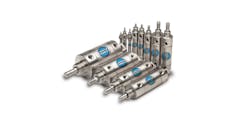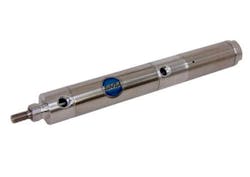Specifying the right cylinder is the first and most important way to maximize the performance and longevity of your components. Several factors affect cylinder performance., including:
1. Size and force of the cylinder relative to the load
2. Proper mounting
3. Environmental factors (and more)
That’s why it’s so important for you to obtain a standard or custom-designed cylinder for any application, no matter how unique.
Cylinders can be categorized by the type of action they perform as well as the kind of construction they offer. Selecting the proper linear action depends on the task that needs to be accomplished. Cylinders can provide a variety of function types. Many single acting cylinders incorporate a built-in spring which returns the piston to its original starting position. The power in a single acting cylinder is provided on the extension or push stroke only. A reverse single acting cylinder is similar to a single acting but has the port on the opposite end to provide power under retraction or pull stroke only.
A double-acting cylinder has dual air ports to provide power on both the extension and retraction stroke, eliminating the need for a spring return.
To determine what cylinder is best for the task at hand, you need to answer three key questions:
1. How heavy is the load to be moved? The answer to this is usually a given, established by machine design. In order to move a load, you will need to choose a cylinder that provides force greater than the load. It’s a good idea to allow an additional factor of 25% force over load to compensate for friction.
2. What’s the required velocity? Velocity can also be set by machine design. For best results, we recommend using moderate speed because the greater the velocity required the greater the additional force needed to achieve it.
3. What’s the minimum effective air pressure needed to keep your pressure source constant? To maximize cylinder life and performance you need to provide consistent air flow at the minimum effective pressure to maintain the desired velocity. Ideally, the cylinder should be able to move the minimum load at the minimum acceptable velocity and at the minimum available air pressure.
The force generated by the cylinder is determined by the bore size translated into a power factor times the air pressure. The power factor of each bore size approximately reflects the area of the piston. (Of course every application is a little different and other factors may apply.)
Once the cylinder size has been determined, consider:
- Stroke length: Calculate how far the piston needs to extend or retract to perform the task
- Spring force: It must be sufficient to return the piston to its start position including any parts or external loads connected to the cylinder rod.
- Overall dimensions: Measure the space available to be sure it will accommodate the cylinder’s mounting and operating requirements.
Which is the best mounting style for your cylinder?
Choosing the correct mounting style for your cylinder’s size, force and function has a direct effect on its service life. The wrong mounting or incorrect installation can result in side load which can cause excessive wear on the piston, piston rod, rod bearing and seal. When wear occurs, leaking usually follows and that’s how cylinders fail.
Side load occurs when a load is placed on the piston rod without guidance or support or when the mounting and piston rod connection are misaligned. Mounting styles include:
- Pivot-type mountings: clevis, pivot and trunnion. These types of mounting can eliminate side loads in one plane but careful alignment in the other plane is crucial.
- Rigid-mount cylinders: To avoid side loads, side-mounted, nose-mounted, flange-mounted and face-mounted cylinders must be carefully aligned with the direction of load travel.
There are several other options designed for cylinders to prevent side load or shock from excessive impact.
- Cushions: This option prevents excessive end of stroke impact which can cause the cylinder to fail prematurely.
- Bumpers: This option minimizes noise and vibration.
- Stop tubes or dual pistons: These options are used to help reduce side loads by spreading out the distance between the rod bearing and the piston, thus reducing the effective load at these two points.
- Rod wipers: These provide automatic piston rod cleaning after each stroke to prevent foreign substances from entering the cylinder.
Other issues and solutions:
Flow controls assure more reliable control and consistent piston speed. Inconsistent air pressures can cause unpredictable stroke speed rates, and air pressure that’s too low may cause irregular movement of the piston rod during the stroke.
The solution to these problems is the installation of a flow control device on your cylinder to assure constant controllable air flow for precise and consistent speed control
The working environment can also have a direct, negative effect on your cylinders. Here are some environmental factors to consider:
- Is the operating temperature outside the normal range of -20º F and positive 200º F? For best results specify cylinders and seals constructed of heat or cold resistant materials and be especially vigilant with regular maintenance.
- Will the cylinder be exposed to radiation, caustic washdowns or other harmful substances? At the worksite cylinders are often exposed to harmful substances related to the specific process. If the substance is corrosive special finishes and materials help prolong the cylinder service life.
- Are there contamination threats to cylinder interiors? Mechanical solutions such as wipers and scrapers offer protection. For extra protection you can install rod boots which are bellows that fit around the rod piston and expand and contract as the rod extends and retracts.
Finally, you can extend the life of your cylinders with prescribed lubrication and maintenance. Recently, cylinders permanently lubricated from the factory have become much more popular lessening the importance of maintaining proper lubrication levels through the cylinder’s life. However, for cylinders that require lubrication one of the keys is maintaining proper lubrication levels. Cylinders that are not sufficiently lubricated can overheat causing damage to components and degradation of seals.
These tips will help assure maximum cylinder performance in any application you choose.
For more info, visit: https://www.bimba.com/











